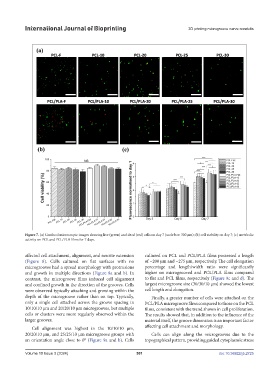Page 509 - IJB-10-3
P. 509
International Journal of Bioprinting 3D printing microgroove nerve conduits
Figure 7. (a) Confocal microscopic images showing live (green) and dead (red) cells on day 7 (scale bar: 300 µm); (b) cell viability on day 7; (c) metabolic
activity on PCL and PCL/PLA films for 7 days.
affected cell attachment, alignment, and neurite extension cultured on PCL and PCL/PLA films possessed a length
(Figure 8). Cells cultured on flat surfaces with no of ~200 µm and ~275 µm, respectively. The cell elongation
microgrooves had a spread morphology with protrusions percentage and length/width ratio were significantly
and growth in multiple directions (Figure 8a and b). In higher on microgrooved and PCL/PLA films compared
contrast, the microgroove films induced cell alignment to flat and PCL films, respectively (Figure 9c and d). The
and confined growth in the direction of the grooves. Cells largest microgroove size (30/30/10 µm) showed the lowest
were observed typically attaching and growing within the cell length and elongation.
depth of the microgroove rather than on top. Typically, Finally, a greater number of cells were attached on the
only a single cell attached across the groove spacing in PCL/PLA microgroove films compared to those on the PCL
10/10/10 µm and 20/20/10 µm microgrooves, but multiple films, consistent with the trend shown in cell proliferation.
cells or clusters were more regularly observed within the The results showed that, in addition to the influence of the
larger grooves. material itself, the groove dimension is an important factor
Cell alignment was highest in the 10/10/10 µm, affecting cell attachment and morphology.
20/20/10 µm, and 25/25/10 µm microgroove groups with Cells can align along the microgrooves due to the
an orientation angle close to 0° (Figure 9a and b). Cells topographical pattern, providing guided cytoplasmic stress
Volume 10 Issue 3 (2024) 501 doi: 10.36922/ijb.2725

